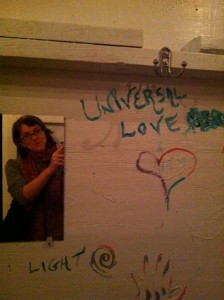 I’ll give all the talk-talk-talk about utopia a rest after this, I swear.
I’ll give all the talk-talk-talk about utopia a rest after this, I swear.
A busy few days here. In the main, I went camping for the weekend with my son’s newly formed Earth Scouts troop, and on Monday gave my first lecture on women’s utopian narrative at Florida Southern College.
Related, how?
Earth Scouts is kind of like Boy/Girl Scouts, except instead of fundraising, its program is designed to further the goals of the Earth Charter; namely, social justice, sustainability, and peace. The program doesn’t just educate about these ideas; kids are encouraged to take specific action to change the world for the better. Lofty vision, to be sure, and it sounds worthwhile.
However, at the parents’ meeting I found myself wondering how to teach these values to young, squirming kids (who spent the larger part of the weekend running full-tilt until they dropped instead of, say, playing video games). I know there are ways, but overall I was skeptical. Creating meaningful change in the world is a big charge to put on tiny shoulders. Plus, I find these concepts are synonymous with a Unitarian Universalist education, which most of them are getting already.
Heck, I just wanted to go camping, watch kids roast marshmallows, bang some drums around the campfire, and we did all those things, too. But it got me thinking.
The campground itself is an experiment in peace, sustainability and justice, rooted in a cooperative tradition that may seem a little hippy to the rest of the world. My favorite part is the bathhouse, built several years ago and covered with constantly updated art and slogans promoting peace and pagan culture.
The campground was a good space for me to think about what brings me peace, how I can cultivate joy in my life, how I can be true to my ideals. But it’s not enough to contemplate, to wish and dream. Like the Earth Scouts, I have to take action to reach those goals knowing they may be just beyond my grasp. I may have to accept that my dreams are too big, my aspirations too lofty. I may have to accept failure while acknowledging the attempt as worthwhile, even vital.
To me, striving is the essence of utopia, not reaching a state of perfection. It’s the “no-place,” after all. If it was easy to get there, it wouldn’t be so fascinating, so tantalizing there on the horizon. It wouldn’t be worth the risk.
On Monday, I tried explaining this to a bunch of sleepy undergrads. Some of them grasped the idea, went along with me for the ride. I had carefully prepared notes that I essentially ignored, and plowed right into explicating the thrills of speculation and world-building, the social ramifications of utopian dreaming, the influence of Charlotte Perkins Gilman’s Women and Economics, the fuzzy line demarcating the boundaries of utopia and dystopia…
Until the brightest bulbs began to glaze over, and I released them into the world. I can hope they took some of my dreamy utopian striving along with them.
 I’m spending the week at The Rainforest Village Resort in the Olympic National Forest. It may just be the most beautiful place on earth, and it’s a fantastic location for a writing retreat.
I’m spending the week at The Rainforest Village Resort in the Olympic National Forest. It may just be the most beautiful place on earth, and it’s a fantastic location for a writing retreat.

